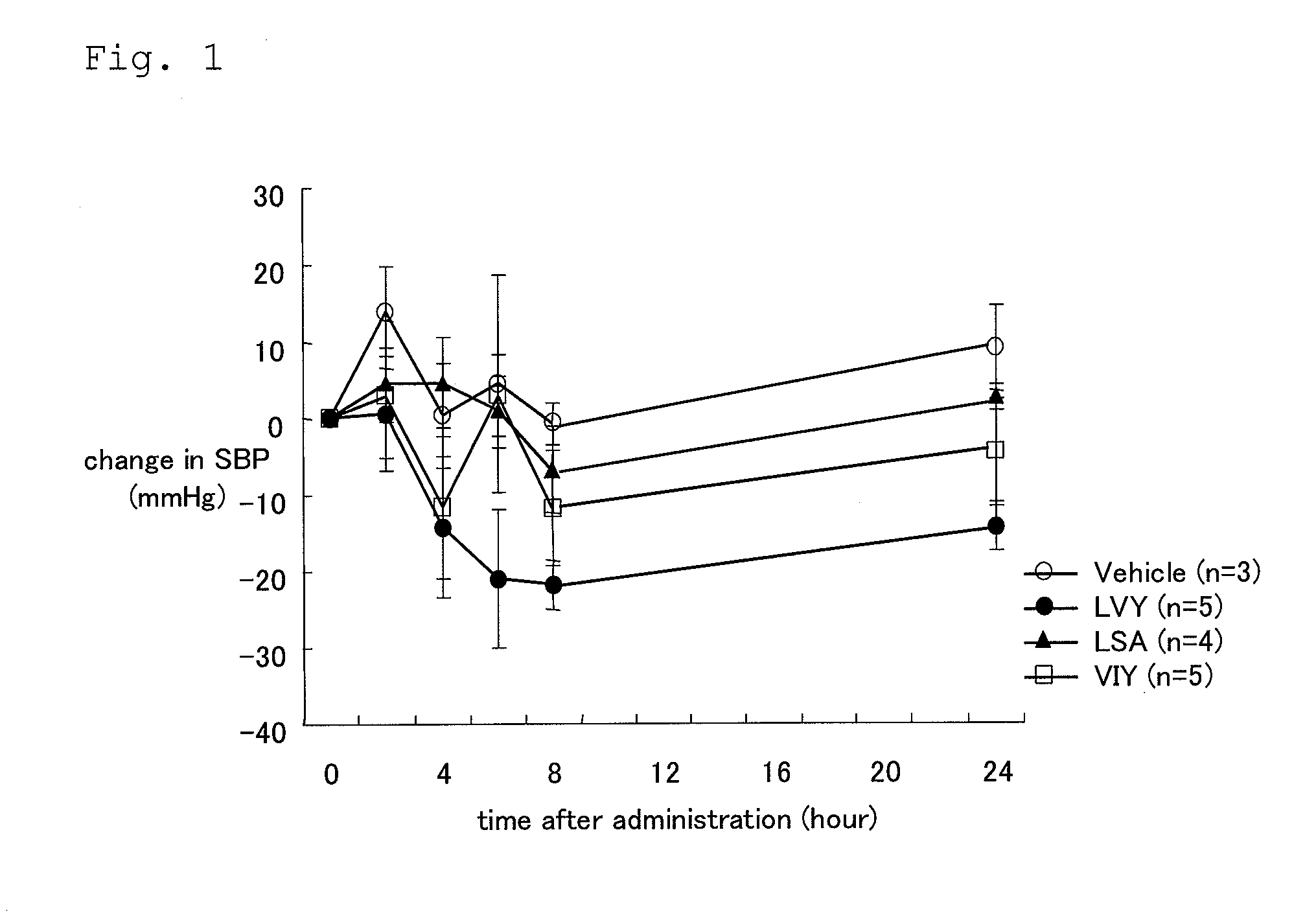Angiotensin-converting enzyme inhibitory peptides
an angiotensin-converting enzyme and inhibitory peptide technology, applied in the field of peptides, can solve the problems of degrading bradykinin, peptides composed of longer amino acid chains cannot achieve the hypotensive effect of the level, and are easily absorbed, so as to achieve the effect of less tendency to lose ace inhibitory activity and not easily digested
- Summary
- Abstract
- Description
- Claims
- Application Information
AI Technical Summary
Benefits of technology
Problems solved by technology
Method used
Image
Examples
example 1
Production and Purification of Peptide
[0036]2 L of water was added to 100 g of defatted sesame and the pH value of the resultant mixture was adjusted to 12.0 to 12.5 by adding NaOH. After stirring at 55° C. for 1 hour, the mixture was filtered to give a protein extract. HCl was added to the protein extract to adjust the pH value to 4.0. After centrifuging, sesame protein (weight on dry basis: 19.8 g) was obtained.
[0037]To 10 g of the obtained sesame protein, 300 ml of water was added and the pH value of the mixture was adjusted to 7.5 with NaOH. Then 10 mg of thermolysin (Nacalai Tesque, 7000 PU / mg) was added thereto and the mixture was reacted under gentle stirring at 65° C. for 6 hours. After the completion of the reaction, HCl was added to the reaction mixture to adjust to pH 4.0 and the thermolysin was inactivated by heating to 90° C. for 10 minutes. After heating, the thus formed precipitate was removed by centrifugation and the supernatant was filtered through paper filter (To...
example 2
Production of Peptides by Chemical Synthesis
[0071]Using an automatic peptide synthesizer (Model ABI 430) manufactured by Applied Biosystems, a purposed protected peptide resin was synthesized by starting with the C-terminus and extending the peptide chain successively by the BOC method in accordance with the program.
[0072]After the completion of the construction of the peptide on the resin, the protected peptide resin was dried. The protected peptide thus obtained was deprotected and the peptide was removed from the resin support by treating it with anhydrous hydrogen fluoride (HF / p-Cresol 8:2 v / v, 60 minutes). The crude peptide thus obtained was extracted with 90% acetic acid and then freeze-dried to give a powdery solid. The crude peptide thus obtained was further purified by high-performance liquid chromatography with the use of an ODS column and thus the purposed peptide was obtained.
[0073]Column: YMC-Pack ODS-2 (30 mm ID×250 mm L, YMC).
[0074]Mobile phase: Buffer A: 5% CH3CN, 0....
example 3
Measurement of ACE Inhibitory Activity of Peptide
[0090]The ACE inhibitory activities of the 3 peptides obtained in Example 2 were measured in accordance with the method described above and IC50 values were determined. Table 1 shows the results. As a control, the ACE inhibitory activity of the sesame peptide powder obtained in Example 1 was also measured and the IC50 value thereof was determined.
TABLE 1Inhibitory activity (IC50)Peptideμg / mlμMLeu-Ser-Ala2.48.4Val-Ile-Tyr1.64.2Leu-Val-Tyr0.842.1Peptide powder—50.3
PUM
| Property | Measurement | Unit |
|---|---|---|
| temperature | aaaaa | aaaaa |
| pH | aaaaa | aaaaa |
| pH | aaaaa | aaaaa |
Abstract
Description
Claims
Application Information
 Login to View More
Login to View More - R&D
- Intellectual Property
- Life Sciences
- Materials
- Tech Scout
- Unparalleled Data Quality
- Higher Quality Content
- 60% Fewer Hallucinations
Browse by: Latest US Patents, China's latest patents, Technical Efficacy Thesaurus, Application Domain, Technology Topic, Popular Technical Reports.
© 2025 PatSnap. All rights reserved.Legal|Privacy policy|Modern Slavery Act Transparency Statement|Sitemap|About US| Contact US: help@patsnap.com

